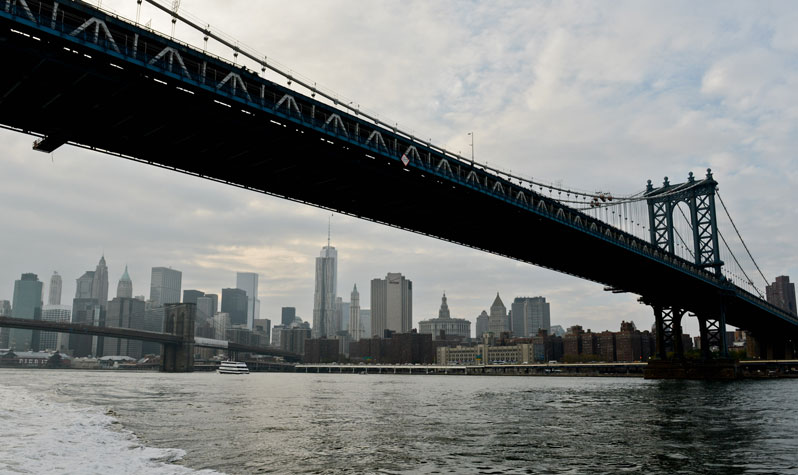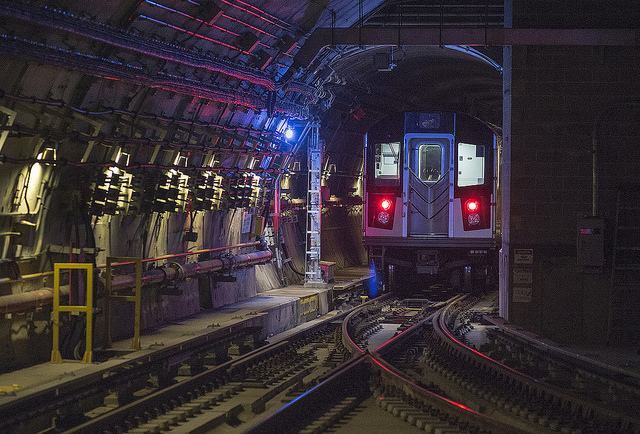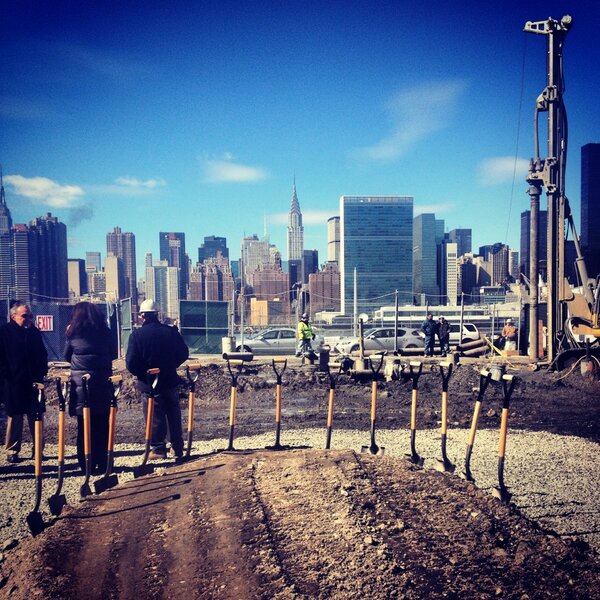The Right Plan for Addressing the Landmarks Backlog

The Brooklyn Bridge, in distance, & The Manhattan Bridge (photo: Daniel Avila/NYC Parks)
Meet Backlog95.
Clunky operating system?
Nope – it's a list of 95 historic places before New York City's Landmarks Preservation Commission.
Commission Chair Meenakshi Srinivasan thinks it's time to make some decisions on which will be given historic landmark status – a reasonable position, as some items have been under the agency's consideration since John Lindsay was mayor.
To clear the pile up, Srinivasan put Backlog95 up for debate for the first time in decades. The list includes icons like the Pepsi Cola sign, Green-wood Cemetery, and Coney Island's charming Art Deco Pumping Station.
Beginning at a packed hearing, landmarks commissioners began reviewing research, listening to testimony, and making decisions based on the merit of each property. The plan is to revisit the entire list at the beginning of 2016, with the end goal of clearing the decks of all outstanding properties – one way or another – by December 2016.
But Srinivasan's plan has competition.
Earlier this year, City Council Members David Greenfield and Peter Koo proposed a new bill – known as Intro. 775 – that would clear the backlog using restrictive new rules, including an 18-month timeline and a five-year moratorium on resubmissions to the Commission.
There are consequences to this approach:
Historic landmark designation is a meticulous process, and a timeline encourages bad actors to delay progress in the hopes of dodging landmark designation.
Even the most obvious landmarks can take time to properly research and consider. But under the bill's current timelines and given the way their process unfolded, both Grand Central Terminal and Radio City Music Hall would have exceeded the window for consideration and would have been sent to the back of the class for five years before landmark protection could be reconsidered.
What sounds like a momentary inconvenience is actually a long time to keep the bulldozers at bay. If we are not careful, we could easily lose places essential to our city's history and future.
The bill's proposed moratorium is even more dangerous, as it places the structural integrity of deteriorating buildings at risk for five years once the clock runs out. That's a lifetime for any building facing our city's brutal winters, especially when the Landmarks Commission has no power to ensure historic buildings are protected from the elements.
"This bill seeks to clear the decks – in the crudest possible way – for the destruction of historic fabric," testified one Lower Manhattan resident at a marathon September 9 hearing. Three-quarters of the hundred other speakers agreed.
Nobody wins when the Commission drags its feet. But if the City Council overreacts, New Yorkers risk losing the places and spaces that make our city great.
That's why we support Srinivasan's fix. It's the best upgrade for Backlog95 – and for the city we love.
***
Simeon Bankoff is Executive Director of the Historic Districts Council. The organization is on Twitter at @HD_NYC.
***
Have an op-ed idea or submission for Gotham Gazette? E-mail editor Ben Max: This email address is being protected from spambots. You need JavaScript enabled to view it.
Albany Transparency and the MTA Funding Deal: Show Us Our Money

Down a dark tunnel (photo: MTA/Patrick Cashin via flickr)
The big news is that Governor Cuomo and Mayor de Blasio have stopped fighting over who should pay what, and reached a deal to close a huge gap in the MTA's vital $26 billion five-year capital plan. But their story of political conflict and compromise obscures a crucial fact: it's not their money, it's ours. Going forward the public has the right to know exactly what the governor and mayor intend to borrow and spend in our names.
Fully funding the MTA is a must, but New Yorkers are going to be stuck with the bill for the new subway trains and buses long after the governor and mayor have moved on. We need to know what they are getting us into.
So far, Governor Cuomo has refused to reveal a specific funding source for his pledge of an additional $8.3 billion, saying only that the money is coming from "state sources." Based on the State's available sources of funding and borrowing, this means it is highly likely that the State will create a mountain of new debt that the MTA and transit riders will be ultimately responsible for.
The governor has said he does not want to raise new taxes and will not push for the Move NY road pricing plan. The State's bank settlements are already spoken for, and the General Fund will not have anywhere near $8.3B in cash to spend on the MTA over the next four fiscal years, especially if Upstate demands equal funding for its roads and bridges. That leaves borrowing.
The State does almost all of its borrowing by getting public authorities, like the MTA, to borrow on its behalf. The State does this to avoid debt limits and public votes. Therefore, by far the most likely way Governor Cuomo will pay for his $8.3B pledge is by having the MTA borrow the money by selling bonds which the State will pledge to pay for. This is called a "service contract bond."
The key thing about service contract bonds is that the State's commitment to pay for them is not legally binding, and the MTA and transit riders are ultimately responsible for paying bondholders if the State reneges on its commitment. If the state does renege on some or all of the promised payments, the MTA and transit riders could be left holding a very large bag: paying back $8.3B in bonds will cost roughly $500 million a year for 30 years.
Unfortunately, Governor Cuomo has a bad track record with MTA service contract bonds. Since 2013, he has reneged on $70 million in State payments for Pataki-era MTA service contract bonds, and his latest budget calls for reneging on another $60M. Instead of the promised State funds, the Governor used MTA funds for the debt payments.
Admittedly, this is a modest amount of money given the MTA's giant budget, but it shows how easy it is for a Governor to break an old promise. If the Governor is reneging on debt payments in today's prosperous times, what happens during bad times over the next 30 years?
Government transparency can be an abstract idea, but for transit riders it really matters right now. The MTA will borrow billions more to pay for its share of the capital plan, and its debt payments are already a dangerously high share of its operating budget. This debt has translated into more expensive MetroCards and an increasing burden on everyday New Yorkers.
The stakes are high and New Yorkers deserve to know from Governor Cuomo, Senate Majority Leader Flanagan and Assembly Speaker Heastie what the risks and benefits are of service contract bond borrowing and other financing options for the MTA capital plan --- after all, it is our money.
***
John Kaehny is the executive director of Reinvent Albany.
***
Have an op-ed idea or submission for Gotham Gazette? E-mail editor Ben Max: This email address is being protected from spambots. You need JavaScript enabled to view it.
The 'Three-Quarter House' System We Need to Embrace

A ground-breaking (photo via @NYCMayorsOffice)
New York City is in a housing crisis, you've surely heard, or seen, or felt. Rents are headed skyward, the homeless shelters are bursting at the seams, and formerly poor and neglected neighborhoods are filled with bearded hipsters drinking craft beers.
For poor people, housing is almost impossible, but for persons in recovery from addiction—or on parole or probation—the challenges are multiplied many times. Felons cannot live in public housing, for example, and the job prospects for someone with a criminal record are very limited. Sobriety is difficult to maintain in the best of circumstances, and stability and peer support are essential.
So what's a poor addict to do? So-called "three-quarter houses" have risen to meet the demand for housing but they are, in some ways, worse than living on the streets. Three-quarter houses can be loosely defined as shared housing for persons in recovery who agree to split expenses and live without illegal drugs or alcohol. They are less restrictive than halfway houses which have strict rules, are usually for felons only, and have paid staff from a managing agency (often the Department of Correction) onsite 24 hours per day.
In New York City, the variant on three-quarter houses that has taken root is unusually predatory and grim. The New York Times has published several articles on these flophouses—a more apt description—where slumlords gouge recovering addicts and former prison inmates for their welfare benefits, house them six to a room and take kickbacks from the treatment programs that the men (mostly) are required to attend.
When a resident completes a drug program they are urged to relapse and be readmitted to a treatment facility, so the landlord can continue getting his kickback. The directors of Narco Freedom, a major provider of substance abuse treatment and three-quarter housing with multiple sites in New York City, have been arrested and indicted on medicaid fraud, and the organization is teetering on the edge of bankruptcy.
The city made a public relations show of closing down a few of these unlicensed and unregulated abominations, but there are hundreds, according to estimates. And there is an endless supply of people seeking cheap and sober housing; the War on Drugs has not abated the number of sufferers but has produced a bumper crop of convict-addicts seeking shelter as they stream out of the jails and prisons.
An estimated 25,000 people are released from New York prisons each year and another 81,000 from New York City jails. Without adequate housing, an addict's chances of staying sober and avoiding criminality are drastically diminished.
There is, however, another model for three-quarter houses that works - and I know from having lived in one.
I spent two years—after a long saga of depression, addiction, incarceration, and treatment—in a three-quarter house run by the non-profit Oxford House group, which manages thousands of such houses nationwide.
Each Oxford House is run on a cooperative basis by its residents. Paid staff manage the start-up phase of each house by finding a rental unit, negotiating a lease, making the upfront payments, and finding the first cohort of tenants. Once established, the tenants pay equal shares toward the rent and utilities, set house rules, assign chores, choose officers, and manage the house on a democratic basis.
Attendance at a treatment program (of the tenant's choice!) or at 12-step groups is a requirement, and if a person relapses the result is an immediate eviction.
The Oxford model is well-established in several states. In New Jersey, for example, there are about 120 houses but it has not caught on in New York (the website lists 17 total houses statewide).
The basic model is simple and any not-for-profit serving these populations could start a three-quarter house by investing a few months of rent upfront. In fact, payback of the initial investment, through small monthly payments from residents, can be part of the model so it need not cost the sponsoring agency a dime.
The basic model can be modified depending on the sponsoring group and the needs of the particular population. For example, the monthly welfare allowance for shelter is reported to be $215 per month per person. It is a low number and it may not be possible to operate a sober house with, say, ten residents, a typical number for the private houses, if all are on welfare. It is likely that a mix of private, paying residents and welfare residents would be required. Otherwise, a small subsidy from the sponsoring agency might be necessary.
Three powerful and intertwined forces—the housing crisis for the poor, the depopulation of the prisons, and the substance abuse epidemic—have combined to create a demand for affordable housing for these often comingled groups. Three-quarter houses, managed responsibly, are one of many answers that are needed.
***
Christopher Beall currently works for the Osborne Association, a nonprofit criminal justice reform group in the Bronx.
***
Have an op-ed idea or submission for Gotham Gazette? E-mail editor Ben Max: This email address is being protected from spambots. You need JavaScript enabled to view it.




